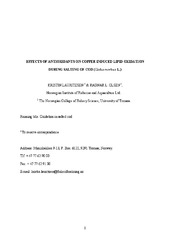Quality of salted cod (Gadus morhua L.) as influenced by raw material and salt composition
Permanent link
https://hdl.handle.net/10037/1819View/
Lauritzsen, K. and Olsen, R.L. (2004). 'Effects of antioxidants on copper induced lipid oxidation during salting of cod (Gadus morhua L.).' Final draft post refereeing. Published: Journal of Food Lipids, Volume 11 Issue 2, Pages 105 - 122. © Wiley. Reprinted with permission. (PDF)
Lauritzsen, K., Martinsen, G. and Olsen, R.L. (1999). 'Copper induced lipid oxidation during salting of cod (Gadus morhua L.).' Journal of Food Lipids, Volume 6 Issue 4, ages 299-315. © Wiley. Reprinted with permission. (PDF)
Lauritzsen, K., Akse, L., Gundersen, B. and Olsen, R.L. (2004). 'Effects of calcium, magnesium and pH during salt curing of cod (Gadus morhua L.).' Final draft post refereeing. Published: Journal of the Science of Food and Agriculture Volume 84 Issue 7, Pages 683 - 692. © Wiley. Reprinted with permission. (PDF)
Lauritzsen, K., Akse, L., Johansen, A., Joensen, S., Sørensen, N.K. and Olsen, R.L. (2004). 'Physical and Quality Attributes of Salted cod (Gadus morhua L.) as Affected by the State of Rigor and Freezing Prior to Salting.' Final draft post refereeing. Published: Food Research International, Volume 37, Issue 7, August 2004, Pages 677-688. © Elsevier. Reprinted with permission. Published version available at http://dx.doi.org/10.1016/j.foodres.2004.03.001 (PDF)
Sørensen, N.K., Brataas, R., Nyvold, T.E. and Lauritzsen, K (1997). 'Influence of early processing (pre-rigor) on quality.' In: Seafood from producers to consumer, integrated approach to quality (J.B. Luten, T. Børresen and J. Oelenschläger, eds.) pp. 253-263. © Elsevier. Reprinted with permission. (PDF)
Thesis introduction (PDF)
Date
2004-03-29Type
Doctoral thesisDoktorgradsavhandling
Author
Lauritzsen, KristinAbstract
Hva påvirker kvaliteten på saltfisk? Saltfiskens lukt, farge, konsistens og smak bestemmer kvaliteten. Dersom torsken blir dødsstiv samtidig med at saltet strømmer inn i fiskekjøttet, oppnår man et lavere vektutbytte, vann- og saltinnhold på sluttproduktet. Fisken bør derfor saltes etter dødsstivheten for å oppnå et høyt vektutbytte. Ønsker man å minimere proteintapet fra salteprosessen og få en høy lyshet på sluttproduktet, bør fisken derimot saltes før dødsstivheten inntrer. Økt kalsium- og magnesiuminnhold samt lav pH i saltet, gir et hvitere og mer fast ferdigprodukt samt et lavere proteintap fra prosessen. Torskefilet har et høyt innhold av flerumettede fettsyrer, og er derfor spesielt utsatt for harskning og fargeendringer ved salting. Det er påvist at torskens muskel-pH (surhet) etter slakting, har betydning for evnen til å motvirke misfarging av ferdigproduktet i nærvær av kopper. Lav muskel-pH ga større misfarging samt lavere vanninnhold i fullsaltet muskel enn høy muskel-pH før salting. Kopper og jern er metaller som naturlig forekommer i fiskekjøtt, salt og drikkevann. Kopper-ioner framskynder harskning i fullsaltet torsk og gir kraftigere gul misfarging av ferdigproduktet sammenlignet med jern. Enverdig kopper er mer harskningsfremmende enn toverdig kopper. For å unngå harskning, er det vanlig å bruke antioksidanter i framstillingsprosessen. Når mer enn 0.1% natriumaskorbat blir tilsatt saltlaken, forhindrer den kopper i å fremme harskning av torskemuskelen. Antioksidantene sitronsyre og EDTA ble også undersøkt, men kun ved lav konsentrasjon sammen med kopper i saltlaken. EDTA var en effektiv antioksidant, mens sitronsyre derimot fremmet harskning i fullsaltet torsk.
Doktorgradsarbeidet ble finansiert av næringsmiddelprogrammet ved Norges forskningsråd i perioden 1997-2001. Muscle contractions simultaneously with a salt influx in the cod muscle probably cause larger reduction in weight, higher water loss and lower uptake of NaCl in muscle salted pre-rigor compared with muscle salted post-rigor. If the primary focus is on the weight yield of the cured product, the fish should be lightly or heavily salted in post-rigor state after chilling or freezing pre- or post-rigor. The fish should be heavily salted in pre-rigor state to reduce the loss of proteins from the raw material and to increase the instrumental lightness values (L*) of the salt ripened cod products. In order to obtain a salt cured product with a white coloured and firm texture and a minimal protein loss during the salting process, the calcium and magnesium contents of the salt should be high (800 and 400 mg Kg-1 respectively) and the pH of the salt/brine should be low (<6). Copper, particularly the reduced form, has a strong pro-oxidative effect on cod muscle lipids and reduces the storage stability of the product. Copper concentration should be kept as low as possible during salt curing of cod. Application of ascorbate as an antioxidant in salt curing of cod requires the use of high concentrations (≥1000 ppm) in the brine. At low (0.5 mM) concentrations used, EDTA was an effective antioxidant while citrate behaved as a pro-oxidant.
Publisher
Universitetet i TromsøUniversity of Tromsø
Metadata
Show full item recordCollections
Copyright 2004 The Author(s)
The following license file are associated with this item:


 English
English norsk
norsk